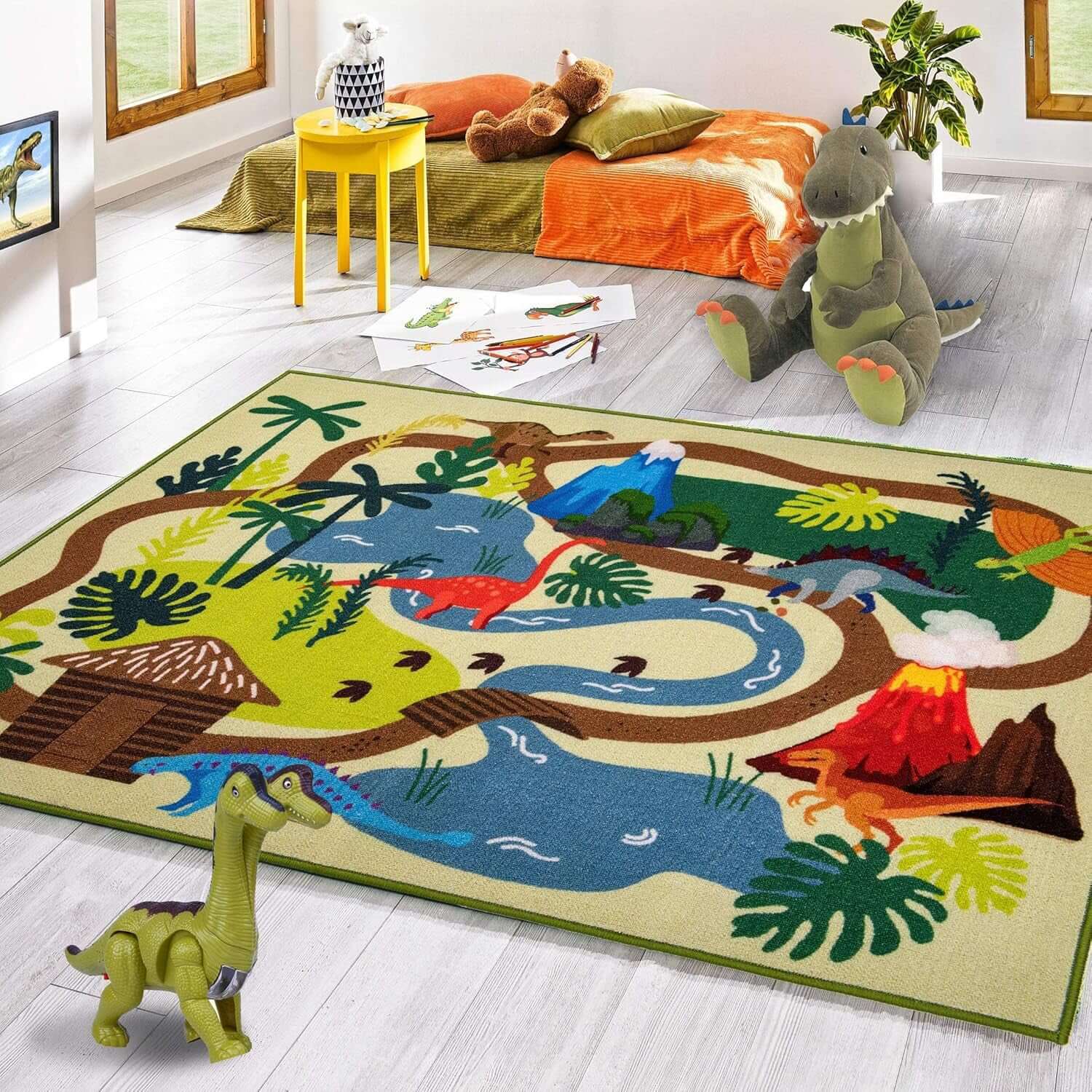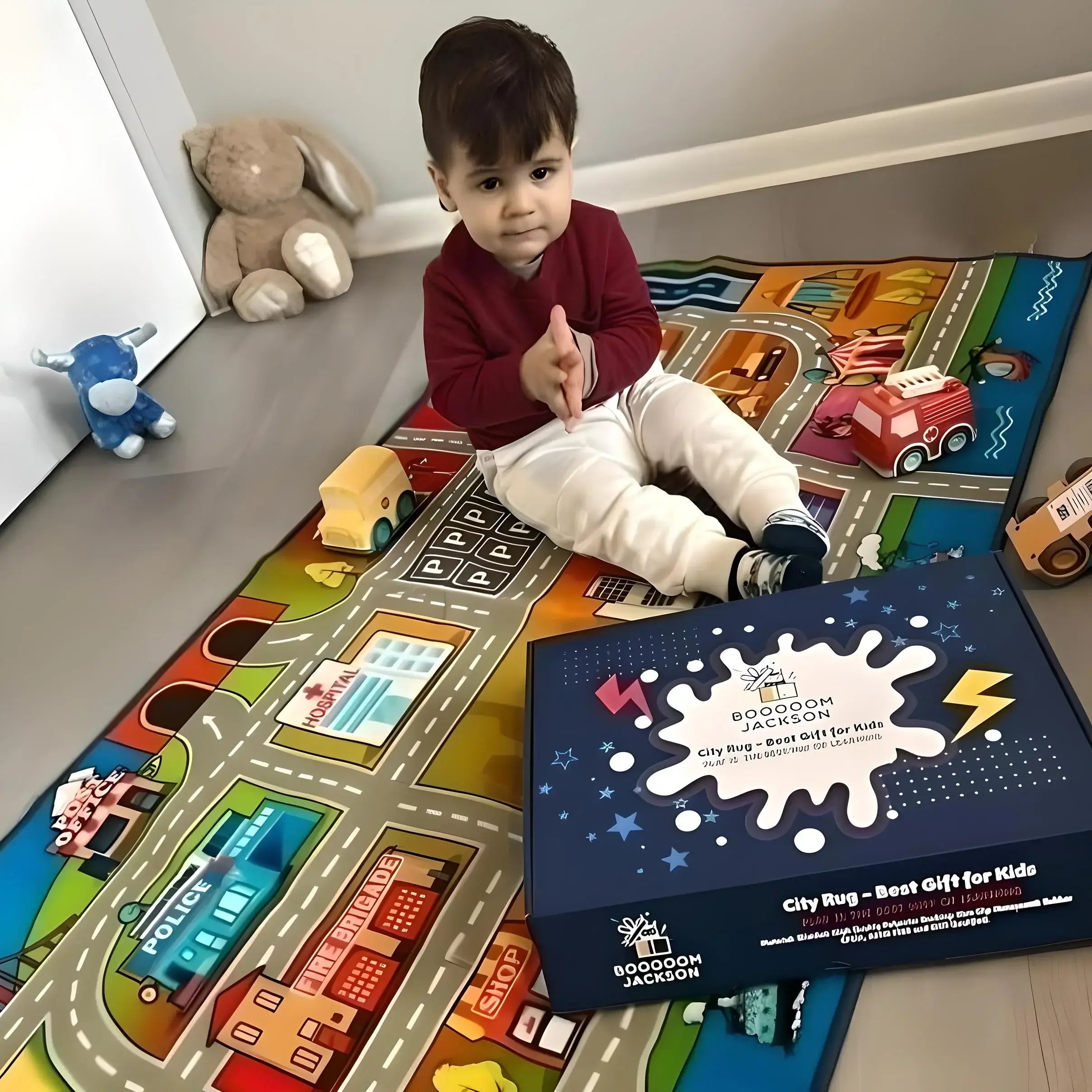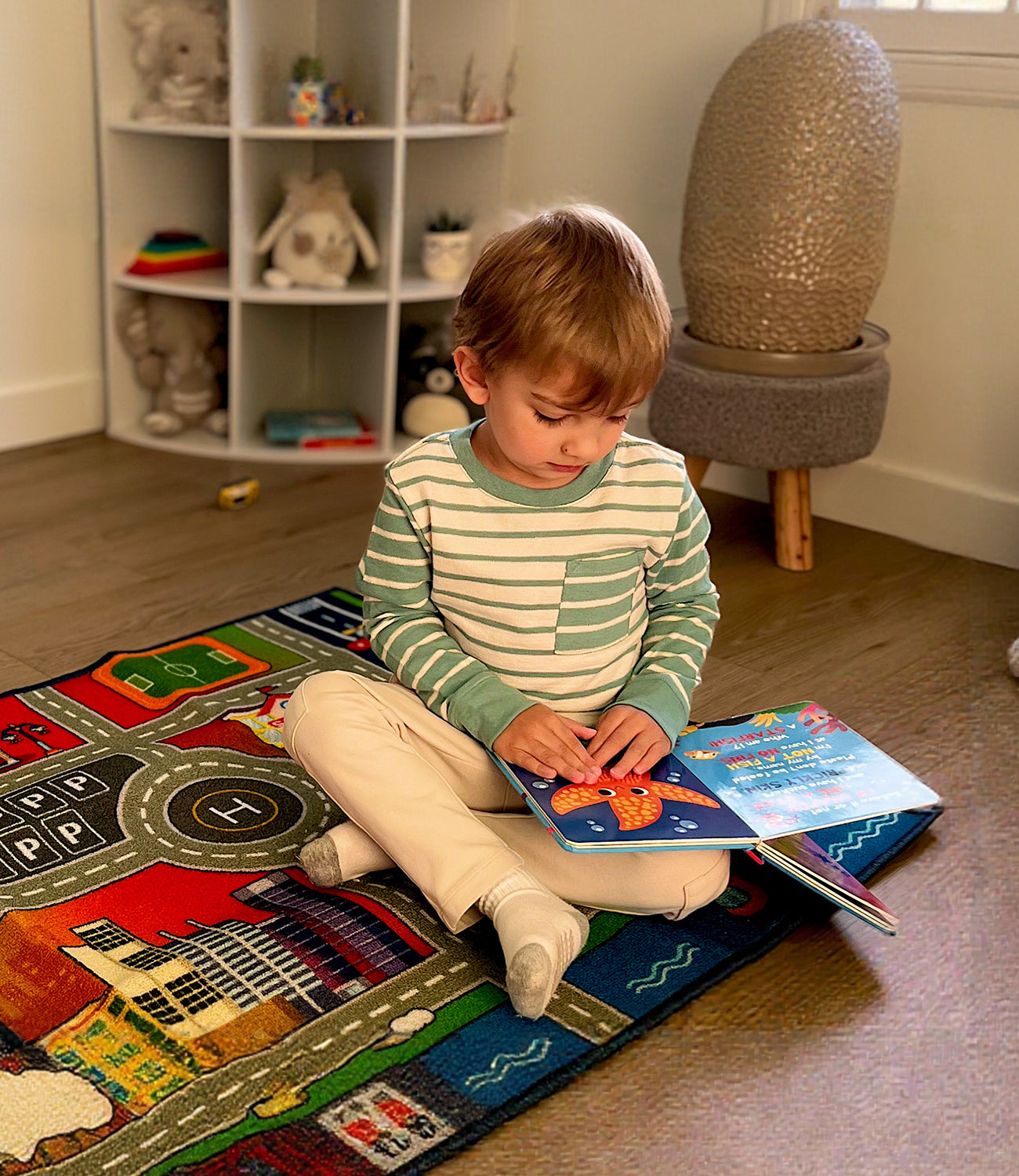The Science Behind Proper Rug Sizing for Children's Spaces
Choosing the right rug size for a child's bedroom or classroom isn't just about aesthetics—it's about creating functional, safe, and psychologically comfortable environments that support healthy development and learning. The "two feet shorter" rule provides the foundation for proper spatial relationships, but understanding why this matters helps you make informed decisions for your specific space.
Modern interior design principles emphasize that rugs should serve as anchoring elements that define spaces without overwhelming them. In children's environments, this becomes even more critical because oversized rugs can make rooms feel cramped and claustrophobic, while undersized rugs can create visual fragmentation that disrupts the sense of cohesion essential for focused play and learning.
Understanding the Two-Feet-Shorter Rule
The Mathematical Foundation
The two-feet-shorter guideline means subtracting 24 inches from both the length and width of your room to determine maximum rug dimensions. For example:
- 10' x 12' bedroom = 8' x 10' maximum rug size
- 12' x 14' classroom area = 10' x 12' maximum rug size
- 8' x 10' nursery = 6' x 8' maximum rug size
This calculation ensures you maintain at least 12 inches of exposed flooring around the rug's perimeter, creating visual breathing room and practical walkways.
Why This Rule Works
Visual Proportion: Design experts recommend that area rugs should cover approximately 25-35% of usable floor space. The two-feet-shorter rule naturally achieves this ideal ratio in most residential and educational settings.
Safety Considerations: Adequate border space prevents trip hazards and allows for safe movement around furniture, particularly important in children's spaces where active play is common.
Psychological Impact: Properly proportioned rugs create a sense of groundedness without visual overwhelm, supporting the calm, organized atmosphere essential for rest and learning.
Room-Specific Sizing Guidelines for Children's Spaces
Nursery and Toddler Bedrooms (Ages 0-3)
Primary Rug Placement:
- Crib-centered layout: 5' x 8' or 6' x 9' rug positioned with front legs of crib on the rug surface
- Play area focus: 6' x 9' to 8' x 10' rug creating dedicated crawling and tummy time space
Safety Considerations: Quality rugs are designed to spark creativity, motor skills, and teamwork, with toddlers practicing balance and color recognition. For nurseries, prioritize slip-resistant backing and hypoallergenic materials that are safe for crawling babies.
Furniture Integration: Position the rug so nursing chairs and changing tables have at least front legs on the rug surface, creating a cohesive furniture grouping while maintaining clear pathways.
Elementary Age Bedrooms (Ages 4-10)
Twin Bed Recommendations:
- Standard placement: 6' x 9' or 7' x 10' rug underneath the bottom two-thirds of the bed
- Extended coverage: 8' x 10' rug for rooms with additional seating or play areas
Full/Queen Bed Sizing:
- Balanced layout: 8' x 10' rug for queen beds, ensuring 18-24 inches extension beyond bed sides
- Luxurious coverage: 9' x 12' rug for spacious bedrooms with sitting areas
Activity Zone Planning: Consider multiple smaller rugs (4' x 6' accent rugs) to define distinct areas for homework, reading, or creative play without overwhelming the primary sleeping area.
Teen Bedrooms (Ages 11+)
Mature Proportions:
- Queen beds: 8' x 10' minimum, 9' x 12' preferred for balanced proportions
- King beds: 9' x 12' standard, 10' x 14' for large bedrooms
Multi-functional Considerations: Teen rooms often serve multiple purposes, requiring careful rug placement to accommodate study areas, socializing zones, and relaxation spaces.
Classroom Rug Sizing for Educational Excellence
Capacity-Based Calculations
Educational professionals recommend allowing at least 24 inches of space per child for comfortable seating during group activities. This translates to specific rug dimensions based on class size:
Small Groups (12-18 students):
- Circular arrangements: 8' round rug for optimal interaction
- Rectangular layouts: 6' x 9' to 7' x 10' rug dimensions
Standard Classes (20-25 students):
- Primary recommendation: 8' x 10' to 8' x 12' rectangular rugs
- Alternative approach: 10' round rug for equal-distance seating
Large Groups (26+ students):
- Comprehensive coverage: 9' x 12' to 10' x 14' rugs
- Sectional approach: Multiple 6' x 8' rugs creating distinct learning zones
Age-Specific Adjustments
Preschool (Ages 3-5): Younger children require more personal space and clear boundaries. Add 15-20% to standard calculations to accommodate developmental needs for physical movement and personal space.
Elementary (Ages 6-11): Standard calculations work well, with emphasis on durable materials that withstand active use while maintaining educational functionality.
Middle School (Ages 12+): Reduce space requirements by 10-15% as students develop better spatial awareness and self-regulation skills.
Advanced Sizing Strategies
The Furniture Relationship Method
Rather than relying solely on room dimensions, consider the relationship between your rug and key furniture pieces:
Bed-Centric Approach:
- Rug should extend 18-24 inches beyond the sides and foot of the bed
- Nightstands can be positioned either on or off the rug, but maintain consistency
- Ensure the rug doesn't extend beyond the room's natural traffic patterns
Activity-Focused Sizing: For classrooms and playrooms, size rugs based on intended activities:
- Reading circles: Allow 2-3 feet diameter per child for comfortable cross-legged seating
- Block play areas: Minimum 6' x 8' for building and movement space
- Art activities: Consider washable rugs with extended dimensions for project spread
Multi-Rug Strategies
Layering Approach: Combine a large neutral base rug (following the two-feet-shorter rule) with smaller accent rugs to create flexible, defined spaces within larger rooms.
Zone Definition: Use multiple appropriately-sized rugs to create distinct functional areas:
- 4' x 6' rugs for reading nooks
- 5' x 7' rugs for homework stations
- 6' x 9' rugs for primary sleeping areas
Material and Construction Considerations for Sizing
Pile Height Impact
The thickness of your rug affects how it integrates with your space:
Low-pile rugs (under ¼ inch):
- Can accommodate furniture legs more easily
- Allow for larger dimensions without overwhelming the space
- Ideal for high-traffic classroom environments
Medium-pile rugs (¼ to ½ inch):
- Provide comfort while maintaining proportion
- Work well with the two-feet-shorter rule in most applications
- Balance comfort and practicality
High-pile rugs (over ½ inch):
- May require slightly smaller dimensions to avoid visual weight
- Best suited for low-traffic bedroom applications
- Consider reducing calculated size by 6-12 inches if pile exceeds ¾ inch
Edge Treatment and Borders
Bound edges: Add visual definition, making rugs appear slightly larger Fringed edges: Can add 2-4 inches to overall dimensions Seamless edges: Provide clean lines that work well with precise sizing
Troubleshooting Common Sizing Mistakes
When the Two-Feet-Shorter Rule Doesn't Work
Narrow rooms (under 8 feet wide):
- Consider runners (2-3 feet wide) instead of area rugs
- Use multiple small rugs rather than forcing inappropriate dimensions
Unusually shaped rooms:
- Adapt the rule to maintain proportional relationships
- Consider custom sizing for optimal fit
Budget constraints:
- Choose slightly smaller high-quality rugs over larger low-quality options
- Consider washable rugs that maintain appearance longer
Over-sizing vs. Under-sizing
Signs your rug is too large:
- Furniture appears to "float" on the rug
- Room feels cramped or claustrophobic
- Difficulty accessing storage or closets
Signs your rug is too small:
- Furniture groupings appear disconnected
- Room feels fragmented or incomplete
- Disproportionate to the dominant furniture piece
Measuring and Planning Your Rug Selection
Essential Measurement Steps
- Room Dimensions: Measure length and width of the entire room
- Furniture Layout: Record positions of beds, desks, and storage
- Traffic Patterns: Identify primary walkways and access needs
- Activity Zones: Consider how the space will be used
Visualization Techniques
Painter's Tape Method: Use painter's tape to outline potential rug dimensions on the floor. This allows you to:
- Visualize the final appearance from multiple angles
- Test furniture arrangements
- Identify potential issues before purchasing
Digital Planning Tools: Many rug retailers offer online room planners that allow you to experiment with different sizes and layouts before making final decisions.
Special Considerations for Safety and Functionality
Safety Standards for Children's Rugs
All rugs are rigorously tested to meet ASTM International and CPSC safety standards, made with non-toxic, eco-friendly materials free from PVC, phthalates, and lead, and featuring slip-proof backing to prevent accidents.
Critical Safety Features:
- Slip-resistant backing increases safety by 80%
- Reinforced edges prevent fraying and trip hazards
- Stain-resistant materials for easy maintenance
- Hypoallergenic properties resist dust mites, mold, and mildew
Maintenance and Longevity Considerations
Easy Care Requirements: Quality rugs can be easily cleaned with a regular vacuum cleaner—no special equipment needed. This accessibility ensures consistent maintenance regardless of rug size.
Durability Features:
- Durable nylon fibers resist fading
- Reinforced edges prevent fraying
- Weighted bottoms increase slip resistance
- Professional-grade construction withstands active use
Budget-Conscious Sizing Strategies
Maximizing Value Through Smart Sizing
Quality Over Quantity: A properly-sized, high-quality rug provides better long-term value than an oversized, cheap alternative that deteriorates quickly.
Flexible Arrangements: Choose rug sizes that can transition between different room layouts as children grow and needs change.
Investment Priorities: Focus budget on safety features and durability rather than maximizing dimensions, especially for high-traffic classroom applications.
Cost-Effective Alternatives
Modular Approaches: Consider carpet tiles or multiple smaller rugs that can be reconfigured as needs evolve.
Phased Purchasing: Start with essential sizing and add complementary rugs over time to build comprehensive coverage.
Age-Appropriate Design and Size Integration
Developmental Considerations
Early Childhood (0-5 years):
- Emphasize safety and sensory development
- Choose sizes that accommodate crawling and gross motor activities
- Integrate educational elements with appropriate scale
School Age (6-12 years):
- Balance play and study requirements
- Consider homework and project needs in sizing decisions
- Accommodate sleepovers and social activities
Adolescence (13+ years):
- Respect developing independence and style preferences
- Plan for evolving furniture and activity needs
- Consider long-term durability for extended use
Educational Integration
Learning Support Features: Many educational classroom rugs combine proper sizing with curriculum-supporting designs that enhance rather than distract from learning activities.
Flexibility for Growth: Choose dimensions that accommodate changing educational needs while maintaining the foundational principles of proper spatial relationships.
Technology Integration and Future-Proofing
Modern Classroom Considerations
Interactive Learning Support: Ensure rug sizing accommodates technology integration without compromising safety or accessibility.
Adaptable Configurations: Plan for evolving educational approaches that may require different spatial arrangements.
Home Learning Environments
Dual-Purpose Sizing: Consider dimensions that support both rest and remote learning activities in bedroom settings.
Family Interaction: Size rugs to accommodate parent participation in homework and reading activities.
Professional Installation and Placement Tips
Optimal Positioning Strategies
Room Entry Considerations: Position rugs to create welcoming transitions from doorways while maintaining clear traffic flow.
Natural Light Integration: Consider window placement and seasonal light changes in final positioning decisions.
Ventilation and Climate: Ensure rug placement doesn't interfere with heating/cooling vents or air circulation patterns.
Long-Term Maintenance Planning
Seasonal Adjustments: Plan for potential repositioning based on changing light patterns and room usage.
Cleaning Accessibility: Ensure chosen dimensions allow for thorough cleaning around and under furniture.
Environmental and Sustainability Considerations
Eco-Friendly Sizing Approaches
Resource Efficiency: Right-sizing reduces material waste while providing optimal functionality.
Longevity Planning: Proper sizing contributes to extended rug lifespan by preventing premature wear from inappropriate use patterns.
Sustainable Materials: Modern eco-friendly rugs combine proper sizing with environmental responsibility, supporting both immediate needs and long-term planetary health.
Conclusion: Creating Perfect Spatial Relationships
Choosing the right size rug for children's bedrooms and classrooms requires balancing mathematical guidelines with practical needs and safety considerations. The two-feet-shorter rule provides an excellent starting point, but successful rug selection considers the unique characteristics of each space and its intended users.
By understanding the relationship between room dimensions, furniture placement, intended activities, and developmental needs, you can create environments that support healthy growth, effective learning, and joyful living. Whether you're designing a cozy nursery, an active classroom, or a teen's retreat, proper rug sizing contributes to spaces that feel both beautiful and functional.
Remember that the best rug size is one that serves your specific needs while adhering to proven design principles. When you combine the foundational two-feet-shorter rule with careful consideration of safety standards, educational requirements, and individual preferences, you create spaces where children can thrive.
Quality educational rugs that meet proper sizing guidelines become more than floor coverings—they become foundations for learning, playing, and growing that will serve children well throughout their developmental journey.




Leave a comment
This site is protected by hCaptcha and the hCaptcha Privacy Policy and Terms of Service apply.